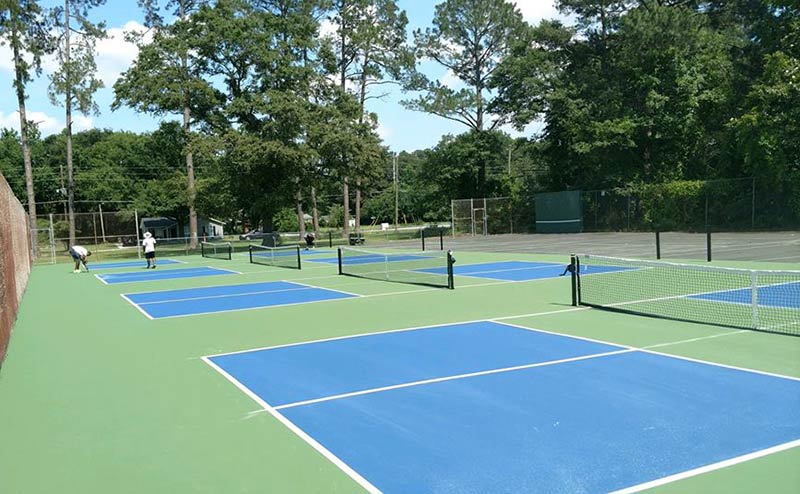Premium Pickleball Court Construction for Every Degree of Play
Premium Pickleball Court Construction for Every Degree of Play
Blog Article
Lasting Practices in Pickleball Court Building And Construction You Ought To Know
As the popularity of pickleball continues to rise, so as well does the need for sustainable practices in court building and construction. The effect of these techniques extends much past the court itself.
Selecting Eco-Friendly Products
Choosing green materials is an important action in the construction of sustainable pickleball courts. The selection of lasting materials not only lessens ecological influence but likewise improves the durability and performance of the court. Secret materials consist of reused rubber for the surface area, which offers outstanding longevity and shock absorption while drawing away waste from landfills.
Additionally, using in your area sourced products minimizes transport emissions and sustains local economies. Pickleball court construction. As an example, using indigenous woods for secure fencing and seats can give a lasting aesthetic while guaranteeing resilience versus the components.
Incorporating absorptive materials for court foundations can better add to sustainability by permitting all-natural water drain and minimizing overflow. These options not just protect regional communities but also advertise much healthier play environments.
Reliable Water Drainage Solutions
While the selection of eco-friendly products is important, applying efficient drain services is just as crucial for preserving lasting pickleball courts. Correct drainage not only secures the court surface area from water damage but likewise decreases disintegration and runoff, promoting environmental honesty.
Effective drainage systems can include permeable paving, which enables water to infiltrate the ground instead of merging externally. This lowers the likelihood of standing water, which can result in mold and other maintenance concerns. Additionally, incorporating strategically placed drainage channels and swales can direct excess water away from the court area, ensuring a completely dry having fun surface and avoiding dirt disintegration.
Using indigenous greenery in the landscaping around the courts can further boost water drainage by soaking up excess water and decreasing runoff. These plants need less watering and promote biodiversity, straightening with lasting methods.
Furthermore, it is essential to routinely keep the drain system to guarantee its lasting efficiency. This consists of cleaning particles and tracking for clogs. By focusing on effective water drainage services, pickleball court contractors can significantly add to the sustainability and longevity of the center, ultimately profiting both gamers and the environment.
Energy-Efficient Illumination Options
As the demand for pickleball proceeds to grow, integrating energy-efficient lighting alternatives right into court style has ended up being progressively crucial for sustainability. Traditional illumination systems frequently consume extreme power, adding to higher operational prices and environmental impact. Embracing contemporary, energy-efficient innovations is crucial for both brand-new buildings and improvements.
LED (Light Emitting Diode) lights attracts attention as a top selection as a result of its durability and power cost savings (Pickleball court construction). Compared to conventional lights, LEDs utilize around 75% much less energy and can last up to 25 times much longer, dramatically lowering maintenance prices. The directional nature of LED lighting lessens light pollution, making certain that lighting is focused on the court instead than surrounding areas.

Sustainable Surface Area Alternatives
Exploring sustainable surface options for pickleball courts has acquired grip amongst players and contractors alike. The focus on eco-friendly materials not just straightens with the growing environmental awareness but likewise boosts the efficiency and toughness of the courts.
One prominent choice is making use of recycled rubber, which can be sourced from made use of tires. This material provides excellent shock absorption, lowering the danger of injuries for gamers while promoting sustainability. Additionally, modular ceramic tiles made from recycled plastics offer another sensible choice. These floor tiles are very easy to replace and install, and their versatility enables numerous court setups.
All-natural turf courts are also arising as a lasting selection, promoting biodiversity and minimizing the warmth island effect. However, they need routine maintenance and water, which may not align with all sustainability goals.

Water Conservation Techniques

Another reliable method involves the installment of rainwater harvesting systems. These this content systems collect and save rain for use in maintaining court surface areas and landscaping. This strategy not just preserves drinkable water but likewise lowers dependence on community resources.
Furthermore, employing drought-resistant landscape design around the courts is vital. Indigenous plants require less water and are much better adapted to regional environment conditions, therefore decreasing total water usage. In addition, using efficient irrigation systems, such as drip irrigation, makes certain that water is delivered directly to plant roots, decreasing dissipation and waste.
Conclusion
Integrating lasting practices in pickleball court building considerably adds to ecological conservation and resource performance. Utilizing environmentally friendly products, implementing efficient water drainage services, and taking on energy-efficient illumination alternatives can significantly lower environmental impact. Discovering lasting surface area options and utilizing water preservation strategies improve the overall sustainability of these recreational centers. By prioritizing these practices, the building of pickleball courts can align with more comprehensive ecological goals while promoting long life and performance within neighborhoods.
As the appeal of pickleball continues to climb, so as well does the demand for sustainable practices in court construction.Selecting environmentally friendly products is a crucial step in the building and construction of lasting pickleball courts. By prioritizing energy-efficient lighting options, pickleball court fabricators can add to a more Extra resources sustainable future while fulfilling the needs of stakeholders and gamers alike.Incorporating lasting surface the original source options not just boosts the efficiency of pickleball courts yet also leads the means for implementing reliable water preservation methods.Integrating sustainable practices in pickleball court construction significantly adds to ecological preservation and resource performance.
Report this page